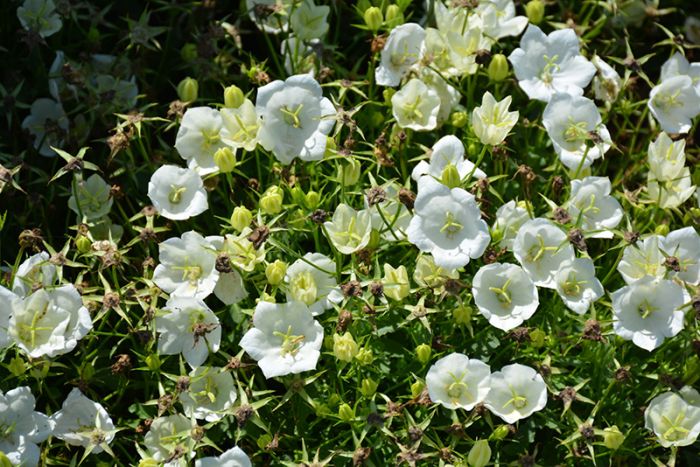Bloom Times for Perennials
A list of bloom times for Perennials. Compiled by and in memory of Gary Pagel, a valued Gertens employee.



Out of stock
Coming soon, still growingThis large, diverse group of plants includes creeping groundcovers, dwarfs, and large upright perennials. Plants are rewarding and easy to grow in rich, moist but well-drained soil. Bellflower (Campanulas) generally do not thrive in nonamended clay soil. Many varieties bloom for a long period of time.
Rapido White Campanula is an early flowering variety, producing bright white flowers. Uniform growth habit with good vigor. Blooms from June through September.Discover an unparalleled selection of perennials at Gertens! With the largest variety in Minnesota, we offer endless options of colorful perennials, natives, and pollinator plants to beautify your garden year after year. From vibrant flowers to lush foliage, our perennials are perfect for adding beauty and charm to your outdoor space. Visit Gertens today and see why we're known as Minnesota's Destination Garden Center!
Campanula carpatica ‘Rapido White’ | Rapido White Campanula
Height: 8 inches
Spacing: 12 inches
Sunlight: ![]()
![]()
Hardiness Zone: 3a
Other Names: Carpathian Harebell, Carpathian Bellflower
Description:
Adorable, compact mound, covered with white cups; perfect in rock, scree and wall gardens, a butterfly magnet; prefers consistent moisture, but not wet soil
Ornamental Features
Rapido White Campanula is bathed in stunning white bell-shaped flowers at the ends of the stems from late spring to late summer. Its round leaves remain emerald green in color throughout the season. The fruit is not ornamentally significant.
Landscape Attributes
Rapido White Campanula is a dense herbaceous perennial with a mounded form. Its relatively fine texture sets it apart from other garden plants with less refined foliage.
This is a relatively low maintenance plant, and is best cleaned up in early spring before it resumes active growth for the season. It is a good choice for attracting butterflies to your yard. It has no significant negative characteristics.
Rapido White Campanula is recommended for the following landscape applications;
Planting & Growing
Rapido White Campanula will grow to be about 8 inches tall at maturity, with a spread of 14 inches. When grown in masses or used as a bedding plant, individual plants should be spaced approximately 12 inches apart. Its foliage tends to remain low and dense right to the ground. It grows at a medium rate, and under ideal conditions can be expected to live for approximately 5 years.
This plant does best in full sun to partial shade. It is very adaptable to both dry and moist locations, and should do just fine under typical garden conditions. It is not particular as to soil type or pH. It is highly tolerant of urban pollution and will even thrive in inner city environments. Consider applying a thick mulch around the root zone over the growing season to conserve soil moisture. This is a selected variety of a species not originally from North America.
Rapido White Campanula is a fine choice for the garden, but it is also a good selection for planting in outdoor pots and containers. It is often used as a 'filler' in the 'spiller-thriller-filler' container combination, providing a mass of flowers against which the thriller plants stand out. Note that when growing plants in outdoor containers and baskets, they may require more frequent waterings than they would in the yard or garden. Be aware that in our climate, most plants cannot be expected to survive the winter if left in containers outdoors, and this plant is no exception. Contact our store for more information on how to protect it over the winter months.
| SKU | Container Size |
| P1072 | #1 Container (1 Gallon) |
* Not all container sizes may be available at this time. See store for details on specific container size availability.
| Common Family Name | Bellflower |
|---|---|
| Gerten Grown Plants | Gerten Grown Plants |
| Sun Preference | Full-Sun, Part-Sun |
| Bloom Time | June, July, August, September |
| Mature Spread (Range) | Under 12" |
| Mature Height (Range) | 7-12" |
| USDA Hardiness Zone | 3, 4, 5, 6, 7, 8 |